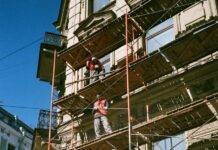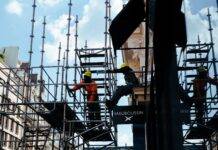
Scaffolding Hazards and Precautions: Ensuring Safety at Heights
Scaffolding Hazards and Precautions : In the bustling world of construction and maintenance, scaffolding stands as an indispensable tool, allowing workers to reach towering heights and accomplish intricate tasks with precision. While it offers numerous advantages, scaffolding also presents a range of hazards that, if not addressed properly, can lead to accidents and injuries. In this comprehensive guide, we’ll delve into the world of scaffolding, exploring the associated dangers and outlining precautionary measures to ensure safety on the job.
Table of Contents
Introduction
Scaffolding, often described as the backbone of the construction industry, facilitates work at significant heights. It provides a stable platform for workers to perform tasks efficiently. However, it’s crucial to recognize that working on scaffolding involves inherent risks, making safety measures paramount.
Understanding Scaffolding
What is Scaffolding?
Scaffolding is a temporary structure erected to support workers, tools, and materials at elevated work sites. It serves as a versatile aid in construction, repair, and maintenance projects.
Types of Scaffolding
Scaffolding comes in various forms, including suspended scaffolds, supported scaffolds, and mobile scaffolds, each designed to suit specific project requirements.
Common Scaffolding Hazards
Falls from Heights
One of the most prevalent scaffolding hazards is the risk of workers falling from significant heights. This often occurs due to inadequate fall protection or lack of proper training.
Structural Instability
Scaffolding must be structurally sound to ensure stability. Failures in the scaffold’s structure can lead to accidents, including scaffold collapses.
Material Falling Hazards
Loose tools and materials left on scaffolding platforms can pose a danger to workers below. Proper storage and securing of materials are essential.
Electrical Risks
When scaffolding is used near power lines or electrical sources, there’s a potential for electrocution. Workers must be aware of electrical hazards and take precautions.
Precautions for Safe Scaffolding
Proper Training and Certification
Workers must undergo comprehensive training and receive certification in scaffold usage, emphasizing safe practices and hazard awareness.
Regular Inspections
Scaffolds should be inspected before each use and after any alterations. This helps identify and rectify potential issues promptly.
Adequate Fall Protection
Fall protection systems, such as guardrails, safety nets, or personal fall arrest systems, must be in place to prevent falls from scaffolding.
Secure Load Handling
Proper loading and distribution of materials on scaffolding prevent overloading and maintain structural integrity.
Weather Considerations
Adverse weather conditions can compromise scaffold safety. Monitoring and adjustments should be made as needed.
Scaffolding Materials and Maintenance
Scaffolding materials must meet industry standards, and regular maintenance is essential to ensure their durability and safety.
Role of Personal Protective Equipment (PPE)
Wearing appropriate PPE, including helmets, harnesses, and safety glasses, is a fundamental aspect of scaffolding safety.
Scaffolding in Extreme Conditions
Scaffolding work may be required in extreme conditions, such as high winds or low temperatures. Special precautions are necessary to mitigate risks.
Legal Requirements and Regulations
Various regulations govern scaffolding safety. Employers must comply with these standards to protect their workers and avoid legal repercussions.
Scaffolding Safety Culture
Creating a culture of safety within the workplace is vital to ensure that all workers prioritize safety while working on scaffolding.
Case Studies: Learning from Past Incidents
Examining past scaffolding incidents and near misses provides valuable lessons on preventing future accidents.
Conclusion
Scaffolding is a vital tool in the construction industry, but it comes with inherent risks. By understanding these risks, implementing proper precautions, and fostering a culture of safety, we can ensure that workers stay safe while working at heights.
FAQs
What is the most common scaffolding hazard?
The most common scaffolding hazard is falls from heights due to inadequate fall protection or lack of proper training.
How often should scaffolding be inspected?
Scaffolds should be inspected before each use and after any alterations to identify and rectify potential issues promptly.
Is wearing PPE mandatory while working on scaffolding?
Yes, wearing appropriate PPE, including helmets, harnesses, and safety glasses, is mandatory to ensure worker safety on scaffolding.
What are some weather-related concerns when using scaffolding?
Adverse weather conditions, such as high winds or low temperatures, can compromise scaffold safety. Monitoring and adjustments should be made as needed.
How can employers promote a culture of safety among scaffolding workers?
Employers can promote a safety culture by providing comprehensive training, enforcing safety protocols, conducting regular safety meetings, and recognizing and rewarding safe practices.
























